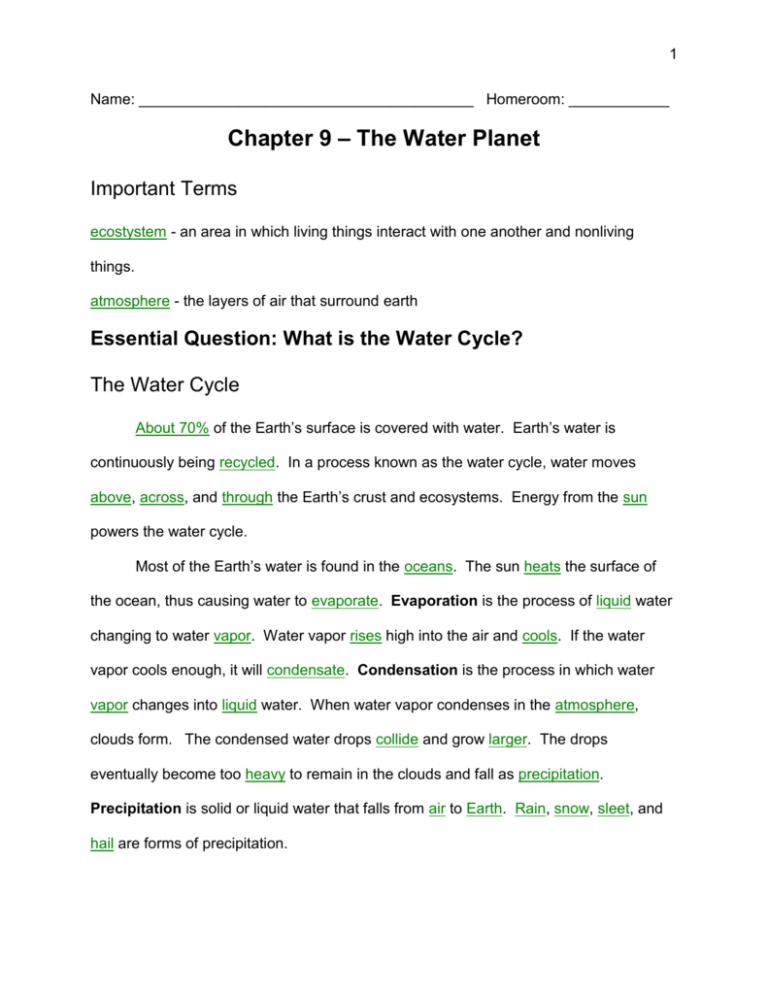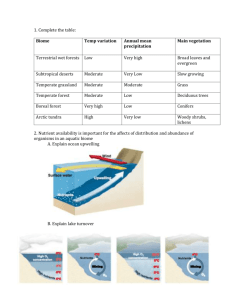Name
advertisement

1 Name: ________________________________________ Homeroom: ____________ Chapter 9 – The Water Planet Important Terms ecostystem - an area in which living things interact with one another and nonliving things. atmosphere - the layers of air that surround earth Essential Question: What is the Water Cycle? The Water Cycle About 70% of the Earth’s surface is covered with water. Earth’s water is continuously being recycled. In a process known as the water cycle, water moves above, across, and through the Earth’s crust and ecosystems. Energy from the sun powers the water cycle. Most of the Earth’s water is found in the oceans. The sun heats the surface of the ocean, thus causing water to evaporate. Evaporation is the process of liquid water changing to water vapor. Water vapor rises high into the air and cools. If the water vapor cools enough, it will condensate. Condensation is the process in which water vapor changes into liquid water. When water vapor condenses in the atmosphere, clouds form. The condensed water drops collide and grow larger. The drops eventually become too heavy to remain in the clouds and fall as precipitation. Precipitation is solid or liquid water that falls from air to Earth. Rain, snow, sleet, and hail are forms of precipitation. 2 Most precipitation falls back in the oceans. The precipitation that lands on the ground can run off the surface, or can soak into the ground. Some of the water recycles back into the atmosphere through the process of plants releasing water vapor into the air through their leaves. The rest of the water in the soil slowly runs down through gaps and pores in rock, known as groundwater. The Water Cycle condensation precipitation evaporation 3 Sources of Fresh Water Our body is made up of 60% to 75% water, about 10 gallons of water. Fresh water is essential for people and many other organisms to survive. Fresh water has a very low salt content. Only about 3% of all the water on Earth is fresh water. Over three-fourths of the freshwater on earth, 75%, can not be used because it is frozen in ice caps and glaciers near Earth’s poles. Almost all of the rest of the Earth’s fresh water is groundwater. In order to get to the groundwater people dig wells and pump the water up to the surface. Only 0.5% of all the freshwater on Earth is in the air, soils, rivers, and freshwater lakes. Minerals are what make salt water salty. When water evaporates from the ocean, the minerals are left behind, thus freshwater can formed from salt water in the ocean. Preserving Our Water Resources Water is one of our most important natural resources, not only because people use freshwater everyday, but also because people use saltwater organisms as a source of food. Groundwater is our richest source of freshwater. Most of the Earth’s water is already polluted; therefore it must be treated before people can use it. Essential Question: What are the Characteristics of the Ocean? The Ocean Floor The ocean floor varies just as the land above water. There are towering mountains, deep valleys, wide plains and other features on the ocean floor. However the ocean floor is divided into 3 major regions. 4 The continental shelf is the first region. The continental shelf is a slowly sloping portion of the ocean floor made up of continental crust. When we walk into the ocean at the beach we are walking on the continental shelf. The continental shelf comes to an end at the edge of the continental slope. The continental slope is a border between continental crust and oceanic crust. Parts of the continental slope are much steeper than others, thus dropping down to the deep-ocean floor. At the end of the continental slope the ocean floor slowly flattens out into the abyssal plain. The abyssal plain is the vast floor of the deep ocean and covers almost half of the earth’s surface. The abyssal plain is covered by a thick layer of sediment, thus making it the flattest place on Earth. Nevertheless some of the Earth’s highest mountains and deepest valleys lie beneath the ocean’s surface. These landforms are along the mid-ocean ridge, where plates are pulled apart and molten rock pushes up from below. How Oceans Affect Climate Nearly three-fourths of the Earth’s surface is covered by oceans, therefore oceans have important effects on Earth’s climate. Without oceans Earth’s climate would be too harsh to support life. It takes water longer to heat up and cool down than it does land, therefore the land can stay cool in the summer and warm in the winter, thanks to help of the oceans. Winds are formed by the differences in water and land temperatures. A sea breeze takes place during the day when the cool air from the ocean moves toward the land and the warm air over the land rises. A land breeze takes place at night when the warm air over the ocean cools and the warm land air takes its place. 5 The ocean flows in a steady, stream like movement known as a current. There are three types of currents: Surface Currents - produced by global winds and move in regular patterns Warm-water Currents - (Gulf Stream) begins in tropical regions carrying warm water from the Caribbean Sea across the North Atlantic to Europe Cool-water Currents - (California Current) form near the poles and flow toward the equator, helping warm climates cool down Ocean Resources Although people do not drink saltwater, they still rely on its resources. In desalination plants the salt and organisms are a major source of food and are gathered and removed from the ocean. Other marine organisms are gathered for non-food products. Saltwater is also a source of sea-salt, which is used for many things including cooking and agriculture. The ocean is also mined for resources, such as petroleum, which is a fossil fuel. The sand that covers the ocean floor also has its uses, such as making concrete. Essential Question: What Lives in the Ocean? Earth’s oceans contain the world’s largest animals. The ocean has many ecosystems, each existing in a major ocean zone. Each ocean zone is a layer of the ocean that has unique types of plants and animal communities. Ocean zones are determined by the depth of the water. 6 Intertidal Zones As depth increases, light decreases. The most shallow and brightest ocean zone is the intertidal zone. The intertidal zone is the area of the ocean between the high tide and low tide. The environment of the intertidal zone is always changing; therefore organisms in the intertidal zone must be able to handle changes in their surroundings. At low tide some find shelter from the sun, while they are pounded by waves as the tide returns. How do some intertidal organisms handle the changes? (list at least 3) During low tide- organisms bury themselves in the mud, hide under rocks, and close their shells tightly. During high tide – organisms open their shells and feed on plankton. Near-Shore and Open-Ocean Zones Moving toward the sea from the intertidal zone, you enter the near-shore zone The near-shore zone includes most of the ocean over the continental shelf, where the water gets no deeper than about 650feet. The relatively shallow, near shore zone gets a lot of sunlight and has a much more stable ecosystem, than the intertidal zone; therefore it is swarming with life. List several organisms that live in the near shore zone. Jellyfish, krill, seaweed, shrimp, and plankton Past the continental shelf, and farther out to sea than the near-shore zone you enter the open-ocean zone. The open-ocean zone includes most of the water over the continental slope and abyssal plain. Most of the animals that here live near the surface. 7 The depth of the open-ocean zone makes food near the surface limited. As a result many organisms are active swimmers, swimming long distances to get food. List several organisms that live in the open-ocean zone. Dolphins, krill, seals, swordfish, tuna, and whales. As depth increases food becomes even more scarce. The extreme darkness means that organisms that rely on sunlight can not live there. The pressure from the water above also makes it difficult for life; at this depth of 3,300 feet most organisms with lungs would be crushed. This deep region makes up 90 percent of the all the oceans and can be compared to the barest desert on land. Most of this open-ocean zone is cold, deep, and dark. Coral Reefs Coral reefs are formed by small animals called corals, which live in shallow, sunlit, near-shore ocean waters. Coral reefs are some of the largest structures on Earth built by living organisms. Although they are large they are very fragile and can be damaged easily. Forming a reef is a slow process. The corals that make up the reef use minerals dissolved in ocean water to form hard outer skeletons. The living corals then attach to the skeletons of the dead corals and ever so slowly a reef forms. List several uses of coral reefs. Provide shelter for many animals Seaweed and plankton are producers in the coral-reef food web. 8 Deep-Ocean Vents Ecosystems that lie more than 3,300 feet beneath the ocean surface do not use sunlight as their energy source, but rather get energy from chemical reactions. On some parts of the ocean floor volcanic vents spew water heated to around 662F. This extremely hot water contains dissolved sulfur- and iron-based chemicals. Certain bacteria use these chemicals, rather than sunlight to produce and store energy.







